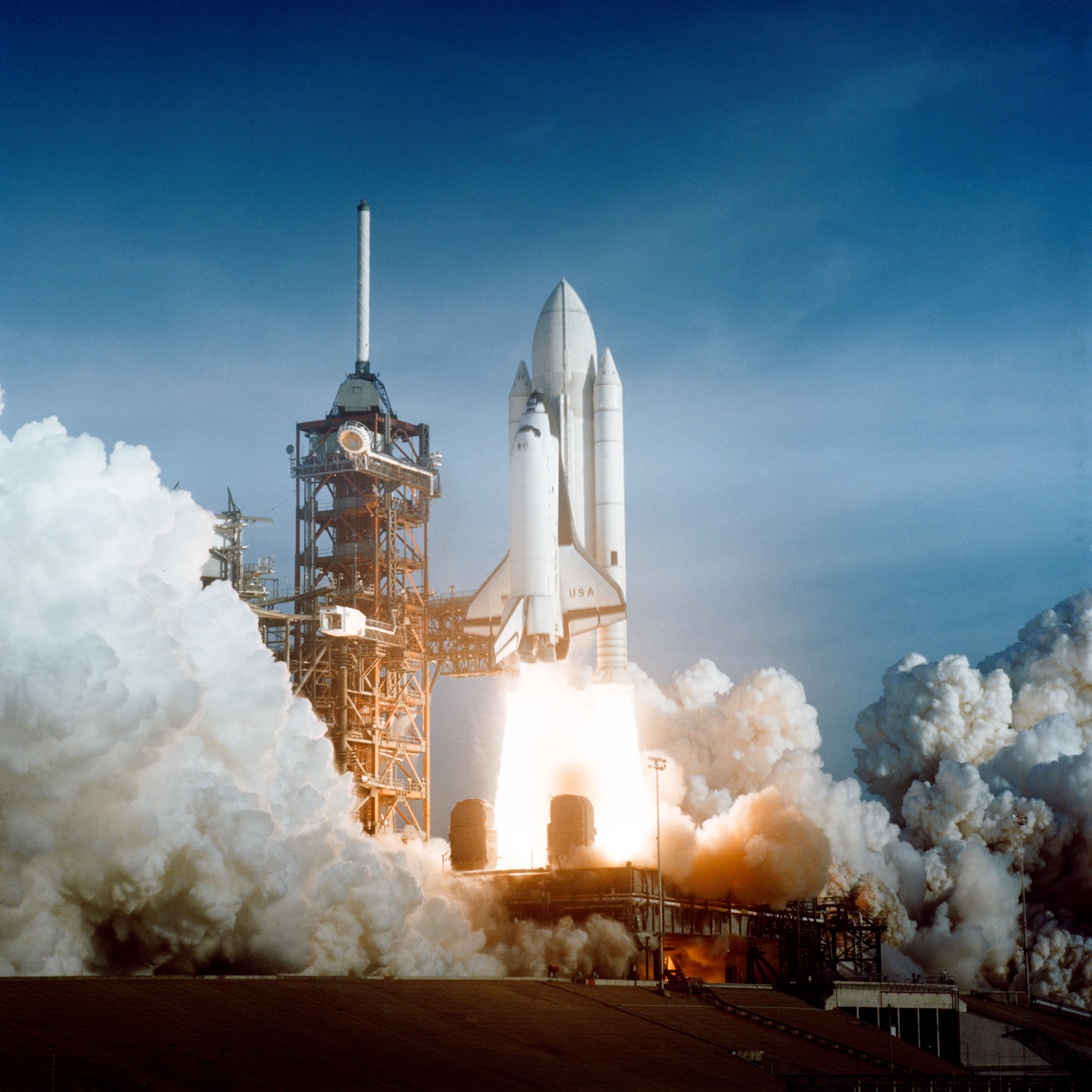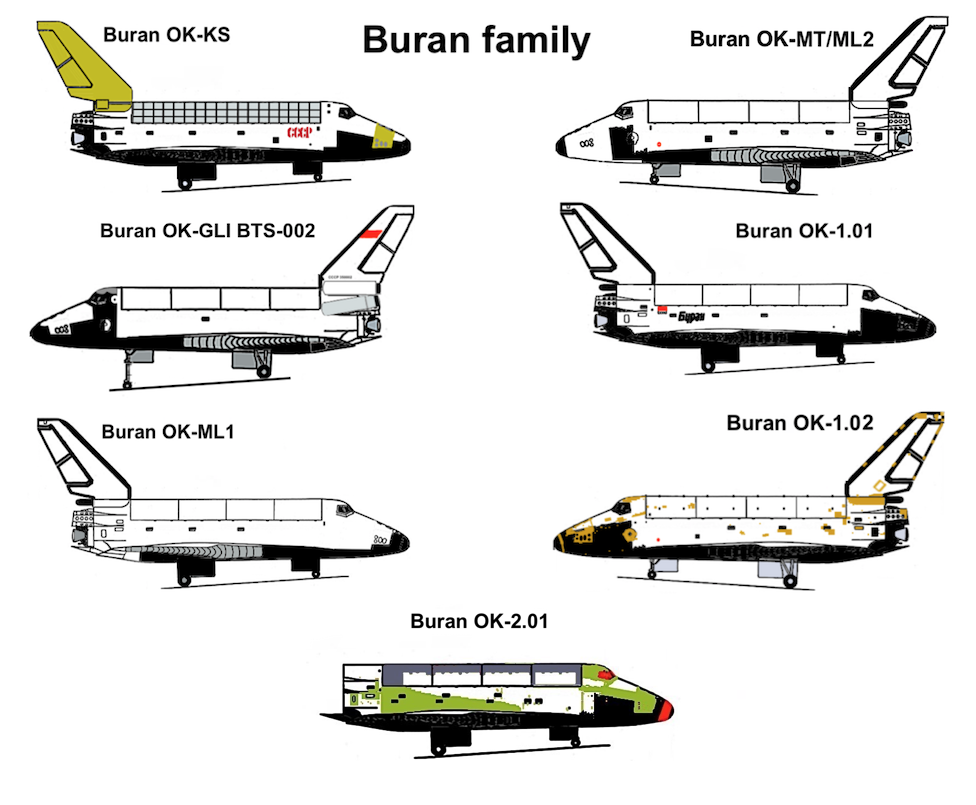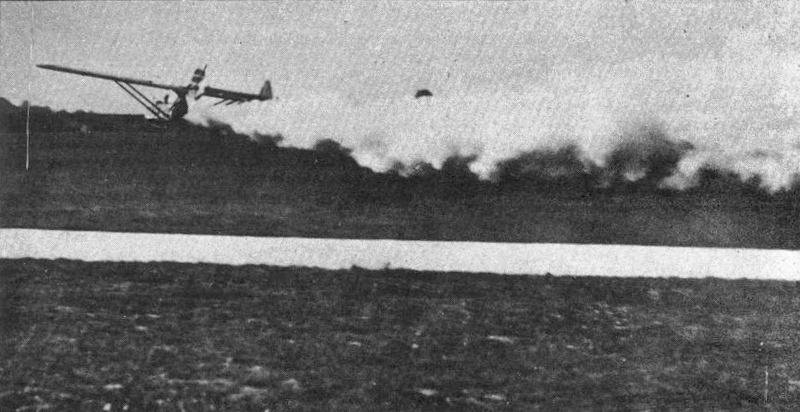|
Spaceplane
A spaceplane is a vehicle that can fly and glide like an aircraft in Earth's atmosphere and maneuver like a spacecraft in outer space. To do so, spaceplanes must incorporate features of both aircraft and spacecraft. Orbital spaceplanes tend to be more similar to conventional spacecraft, while sub-orbital spaceplanes tend to be more similar to fixed-wing aircraft. All spaceplanes to date have been rocket-powered but then landed as unpowered gliders. Four types of spaceplanes have successfully launched to orbit, reentered Earth's atmosphere, and landed: the U.S. Space Shuttle, Russian Buran, U.S. X-37, and the Chinese CSSHQ. Another, Dream Chaser, is under development in the U.S. As of 2019 all past, current, and planned orbital vehicles launch vertically on a separate rocket. Orbital spaceflight takes place at high velocities, with orbital kinetic energies typically at least 50 times greater than suborbital trajectories. Consequently, heavy heat shielding is requi ... [...More Info...] [...Related Items...] OR: [Wikipedia] [Google] [Baidu] |
Boeing X-37
The Boeing X-37, also known as the Orbital Test Vehicle (OTV), is a reusable robotic spacecraft. It is boosted into space by a launch vehicle, then re-enters Earth's atmosphere and lands as a spaceplane. The X-37 is operated by the United States Space Force for orbital spaceflight missions intended to demonstrate reusable space technologies. It is a 120-percent-scaled derivative of the earlier Boeing X-40. The X-37 began as a NASA project in 1999, before being transferred to the United States Department of Defense in 2004. Until 2019, the program was managed by Air Force Space Command. An X-37 first flew during a drop test in 2006; its first orbital mission was launched in April 2010 on an Atlas V rocket, and returned to Earth in December 2010. Subsequent flights gradually extended the mission duration, reaching in orbit for the fifth mission, the first to launch on a Falcon 9 rocket. The latest mission, the sixth, launched on an Atlas V on 17 May 2020 and concluded on 1 ... [...More Info...] [...Related Items...] OR: [Wikipedia] [Google] [Baidu] |
SpaceShipOne
SpaceShipOne is an experimental air-launched rocket-powered aircraft with sub-orbital spaceflight capability at speeds of up to 3,000 ft/s (900 m/s, 3240 km/h), using a hybrid rocket motor. The design features a unique " feathering" atmospheric reentry system where the rear half of the wing and the twin tail booms folds 70 degrees upward along a hinge running the length of the wing; this increases drag while retaining stability. SpaceShipOne completed the first crewed private spaceflight in 2004. That same year, it won the US$10 million Ansari X Prize and was immediately retired from active service. Its mother ship was named "White Knight". Both craft were developed and flown by Mojave Aerospace Ventures, which was a joint venture between Paul Allen and Scaled Composites, Burt Rutan's aviation company. Allen provided the funding of approximately US$25 million. Rutan has indicated that ideas about the project began as early as 1994 and the full-time development cy ... [...More Info...] [...Related Items...] OR: [Wikipedia] [Google] [Baidu] |
Dream Chaser
Dream Chaser is an American reusable lifting-body spaceplane being developed by Sierra Nevada Corporation (SNC) Space Systems. Originally intended as a crewed vehicle, the Dream Chaser Space System is set to be produced after the cargo variant, Dream Chaser Cargo System, is operational. The crewed variant is planned to carry up to seven people and cargo to and from low Earth orbit. The cargo Dream Chaser is designed to resupply the International Space Station with both pressurized and unpressurized cargo. It is intended to launch vertically on the Vulcan Centaur rocket and autonomously land horizontally on conventional runways. A proposed version to be operated by ESA would launch on an Arianespace vehicle. Spacecraft The Dream Chaser design is derived from NASA's HL-20 Personnel Launch System spaceplane concept, which in turn is descended from a series of test vehicles, including the X-20 Dyna-Soar, Northrop M2-F2, Northrop M2-F3, Northrop HL-10, Martin X-24A ... [...More Info...] [...Related Items...] OR: [Wikipedia] [Google] [Baidu] |
List Of Spaceplanes
A spaceplane incorporates aspects of both aeroplanes and spacecraft. Most concepts were only capable of sub-orbital spaceflight. , - , ASSET , , US , , Rocket launch , , Experimental , , 1963 , , Prototype , , , , Uncrewed reentry test vehicle. , - , Boeing X-20 Dyna-Soar , , US , , Rocket launch , , Experimental , , 1963 , , Project , , , , Crewed , - , Boeing X-37 , , US , , Rocket launch , , Utility , , 2010 , , Prototype , , , , Robotic orbiter operated by the United States Armed Forces. , - , BOR-4 , , USSR , , Rocket launch , , Experimental , , 1982 , , Prototype , , , , Uncrewed reentry test vehicle. , - , Buran Shuttle , , USSR , , Rocket launch , , Utility , , 1988 , , Prototype , , , , Crewed orbiter, launched by the Energia rocket. Only one robotic flight made. , - , Dream Chaser , , USA, , Rocket launch , , Utility , , 2004, , Project, , , , Uncrewed orbiter, originally intended as a crew vehicle. la ... [...More Info...] [...Related Items...] OR: [Wikipedia] [Google] [Baidu] |
Spacecraft
A spacecraft is a vehicle or machine designed to spaceflight, fly in outer space. A type of artificial satellite, spacecraft are used for a variety of purposes, including Telecommunications, communications, Earth observation satellite, Earth observation, Weather satellite, meteorology, navigation, space colonization, Planetary science, planetary exploration, and Space transport, transportation of Human spaceflight, humans and cargo spacecraft, cargo. All spacecraft except single-stage-to-orbit vehicles cannot get into space on their own, and require a launch vehicle (carrier rocket). On a sub-orbital spaceflight, a space vehicle enters outer space, space and then returns to the surface without having gained sufficient energy or velocity to make a full Earth orbit. For orbital spaceflights, spacecraft enter closed orbits around the Earth or around other Astronomical object, celestial bodies. Spacecraft used for human spaceflight carry people on board as crew or passengers from ... [...More Info...] [...Related Items...] OR: [Wikipedia] [Google] [Baidu] |
Buran (spacecraft)
''Buran'' (russian: Буран, , meaning "Snowstorm" or "Blizzard"; GRAU index serial number: 11F35 1K, construction number: 1.01) was the first spaceplane to be produced as part of the Soviet/Russian Buran program. Besides describing the first operational Soviet/Russian shuttle orbiter, "Buran" was also the designation for the entire Soviet/Russian spaceplane project and its orbiters, which were known as "Buran-class orbiters". Buran completed one uncrewed spaceflight in 1988, and was destroyed in the 2002 collapse of its storage hangar. The Buran-class orbiters used the expendable Energia rocket, a class of super heavy-lift launch vehicle. It is named after the Asian wind. Construction The construction of the Buran spacecraft began in 1980, and by 1984 the first full-scale orbiter was rolled out. Over 1000 companies all over the Soviet Union were involved in construction and development. The Buran spacecraft was made to be launched on the Soviet Union's super-heavy l ... [...More Info...] [...Related Items...] OR: [Wikipedia] [Google] [Baidu] |
SpaceShipTwo
The Scaled Composites Model 339 SpaceShipTwo (SS2) is an air-launched suborbital spaceplane type designed for space tourism. It is manufactured by The Spaceship Company, a California-based company owned by Virgin Galactic. SpaceShipTwo is carried to its launch altitude by a Scaled Composites White Knight Two, before being released to fly on into the upper atmosphere powered by its rocket engine. It then glides back to Earth and performs a conventional runway landing. The spaceship was officially unveiled to the public on 7 December 2009 at the Mojave Air and Space Port in California. On 29 April 2013, after nearly three years of unpowered testing, the first one constructed successfully performed its first powered test flight. Virgin Galactic plans to operate a fleet of five SpaceShipTwo spaceplanes in a private passenger-carrying service and has been taking bookings for some time, with a suborbital flight carrying an updated ticket price of US$250,000. The spaceplane coul ... [...More Info...] [...Related Items...] OR: [Wikipedia] [Google] [Baidu] |
Spaceflight
Spaceflight (or space flight) is an application of astronautics to fly spacecraft into or through outer space, either with or without humans on board. Most spaceflight is uncrewed and conducted mainly with spacecraft such as satellites in orbit around Earth, but also includes space probes for flights beyond Earth orbit. Such spaceflight operates either by telerobotic or autonomous control. The more complex human spaceflight has been pursued soon after the first orbital satellites and has reached the Moon and permanent human presence in space around Earth, particularly with the use of space stations. Human spaceflight programs include the Soyuz, Shenzhou, the past Apollo Moon landing and the Space Shuttle programs, with currently the International Space Station as the main destination of human spaceflight missions while China's Tiangong Space Station is under construction. Spaceflight is used for placing in Earth's orbit communications satellites, reconnaissance sat ... [...More Info...] [...Related Items...] OR: [Wikipedia] [Google] [Baidu] |
Aircraft
An aircraft is a vehicle that is able to fly by gaining support from the air. It counters the force of gravity by using either static lift or by using the dynamic lift of an airfoil, or in a few cases the downward thrust from jet engines. Common examples of aircraft include airplanes, helicopters, airships (including blimps), Glider (aircraft), gliders, Powered paragliding, paramotors, and hot air balloons. The human activity that surrounds aircraft is called ''aviation''. The science of aviation, including designing and building aircraft, is called ''aeronautics.'' Aircrew, Crewed aircraft are flown by an onboard Aircraft pilot, pilot, but unmanned aerial vehicles may be remotely controlled or self-controlled by onboard computers. Aircraft may be classified by different criteria, such as lift type, Powered aircraft#Methods of propulsion, aircraft propulsion, usage and others. History Flying model craft and stories of manned flight go back many centuries; however, t ... [...More Info...] [...Related Items...] OR: [Wikipedia] [Google] [Baidu] |
North American X-15
The North American X-15 is a hypersonic rocket-powered aircraft. It was operated by the United States Air Force and the National Aeronautics and Space Administration as part of the X-plane series of experimental aircraft. The X-15 set speed and altitude records in the 1960s, reaching the edge of outer space and returning with valuable data used in aircraft and spacecraft design. The X-15's highest speed, , was achieved on 3October 1967, when William J. Knight flew at Mach6.7 at an altitude of , or 19.34miles. This set the official world record for the highest speed ever recorded by a crewed, powered aircraft, which remains unbroken. During the X-15 program, 12pilots flew a combined 199flights. Of these, 8pilots flew a combined 13flights which met the Air Force spaceflight criterion by exceeding the altitude of , thus qualifying these pilots as being astronauts; of those 13flights, two (flown by the same civilian pilot) met the FAI definition () of outer space. The 5Ai ... [...More Info...] [...Related Items...] OR: [Wikipedia] [Google] [Baidu] |
Thermal Protection System Inspections From ISS - Shuttle Nose
A thermal column (or thermal) is a rising mass of buoyant air, a convective current in the atmosphere, that transfers heat energy vertically. Thermals are created by the uneven heating of Earth's surface from solar radiation, and are an example of convection, specifically atmospheric convection. Thermals on Earth The Sun warms the ground, which in turn warms the air directly above. The warm air near the surface expands, becoming less dense than the surrounding air. The lighter air rises and cools due to its expansion in the lower pressure at higher altitudes. It stops rising when it has cooled to the same temperature, thus density, as the surrounding air. Associated with a thermal is a downward flow surrounding the thermal column. The downward-moving exterior is caused by colder air being displaced at the top of the thermal. The size and strength of thermals are influenced by the properties of the lower atmosphere (the ''troposphere''). When the air is cold, bubbles of warm ... [...More Info...] [...Related Items...] OR: [Wikipedia] [Google] [Baidu] |
VTHL
Aircraft can have different ways to take off and land. Conventional airplanes accelerate along the ground until sufficient lift is generated for takeoff, and reverse the process to land. Some airplanes can take off at low speed, this being a short takeoff. Some aircraft such as helicopters and Harrier jump jets can take off and land vertically. Rockets also usually take off vertically, but some designs can land horizontally. Horizontal takeoff and landing Aircraft Conventional takeoff and landing (CTOL) =Takeoff= Takeoff is the phase of flight in which an aircraft goes through a transition from moving along the ground (taxiing) to flying in the air, usually starting on a runway. For balloons, helicopters and some specialized fixed-wing aircraft (VTOL aircraft such as the Harrier), no runway is needed. Takeoff is the opposite of landing. =Landing= Landing is the last part of a flight, where a flying aircraft or spacecraft (or animals) returns to the ground. When the ... [...More Info...] [...Related Items...] OR: [Wikipedia] [Google] [Baidu] |










